You searched for: %EC%8B%A4%EC%8B%9C%EA%B0%84%EB%B0%94%EC%B9%B4%EB%9D%BC%EC%82%AC%EC%9D%B4%ED%8A%B8%20Zx444.TOP%20%EC%BD%94%EB%93%9C%206520%20%EB%B0%94%EC%B9%B4%EB%9D%BC%20%EC%9A%A9%EC%96%B4%20%EA%B5%AD%EB%82%B4%20%EC%99%B8%EA%B5%AD%EC%9D%B8%20%EC%B9%B4%EC%A7%80%EB%85%B8%20%EC%B9%B4%EC%A7%80%EB%85%B8%EC%9D%B8%EC%B2%9C%EC%A0%90%20iEo
<< Previous | Displaying results 351-400 of 561 for "%EC%8B%A4%EC%8B%9C%EA%B0%84%EB%B0%94%EC%B9%B4%EB%9D%BC%EC%82%AC%EC%9D%B4%ED%8A%B8%20Zx444.TOP%20%EC%BD%94%EB%93%9C%206520%20%EB%B0%94%EC%B9%B4%EB%9D%BC%20%EC%9A%A9%EC%96%B4%20%EA%B5%AD%EB%82%B4%20%EC%99%B8%EA%B5%AD%EC%9D%B8%20%EC%B9%B4%EC%A7%80%EB%85%B8%20%EC%B9%B4%EC%A7%80%EB%85%B8%EC%9D%B8%EC%B2%9C%EC%A0%90%20iEo" | Next >>
-
Coining a Word and Championing a Cause: The Story of Raphael Lemkin
ArticlePolish-Jewish lawyer Raphael Lemkin introduced the word genocide in 1944 and lobbied tirelessly for its addition as a crime in international law.
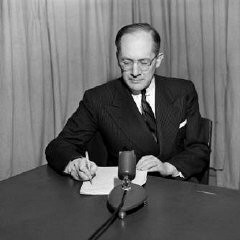
-
Righteous Among the Nations
ArticleRighteous Among the Nations are non-Jewish individuals honored by Yad Vashem, Israel's Holocaust memorial, for risking their lives to aid Jews during the Holocaust.

-
Raphael Lemkin Dies
Timeline EventAugust 28, 1959. On this date, Raphael Lemkin died. He coined the term "genocide" and worked tirelessly for the term to become international law.

-
Establishment of Dachau Camp
Timeline EventMarch 22, 1933. On this date, the SS established the Dachau concentration camp in Germany.
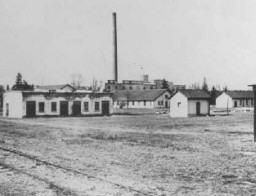
-
Reversal of Fortune: Robert Kempner
ArticleLawyer Robert Kempner was expelled from Germany in 1935. After WWII, he would return to serve as assistant US chief counsel during the IMT at Nuremberg.
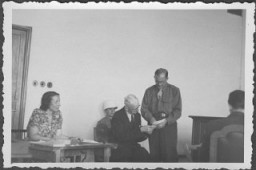
-
Ardeatine Caves Massacre
ArticleNow a national memorial site, the Ardeatine Caves outside Rome were the site of a German reprisal for a bombing by Italian resistance operatives in March 1944.
-
Nesse Galperin Godin describes a roundup in the Siauliai ghetto
Oral HistoryNesse's family had a dairy business. The Germans occupied Lithuania in 1941 and established a ghetto in Siauliai. Nesse lived in the ghetto until 1943 when she was old enough to work. In 1944 Nesse, her mother, and a brother were deported to the Stutthof camp near Danzig. Nesse worked in several Stutthof subcamps until January 1945, when the inmates were put on a death march. She was liberated by the Soviets in March. Nesse, her mother, and two brothers survived, and she arrived in the United States in…

-
Mlynów: "Life under the German Occupation," According to Yehudit Rudolf
ArticleExplore firsthand testimony about the occupation of Mlynów, the establishment of the ghetto, resistance activities, and the destruction of the ghetto.
-
Maria Nemeth
ID CardMaria's parents lived in Szentes, a town in southeastern Hungary, located 30 miles from the city of Szeged. Her mother, Barbara, was born in the neighboring town of Hodmezovasarhely, but moved to Szentes when she married. Maria's father was a dentist. 1933-39: Maria was born in 1932. In 1937 her mother took in a young Austrian woman who lived with the family and helped Maria learn German. 1940-44: In March 1944 German troops occupied Hungary. Members of the Hungarian fascist party, Arrow Cross,…

-
Nazi Rule
ArticleAfter they rose to power in 1933, Hitler and the Nazis eliminated democratic freedoms and took control of all aspects of public life in Germany. Learn more.

-
Eleanor Roosevelt
ArticleEleanor Roosevelt, longest serving First Lady in US history, used her social and political influence to intervene on behalf of refugees before and during WWII.
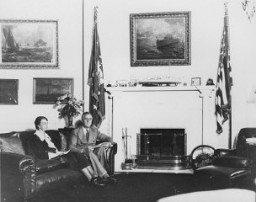
-
Hitler Youth
ArticleThe Hitler Youth and the League of German Girls were developed as Nazi Party youth groups to indoctrinate children and youth in Nazi ideology and policy.

-
The Riegner Telegram
ArticleThe Riegner telegram detailed the Nazi plan to systematically murder European Jews. It was sent to the British and American governments in August 1942.
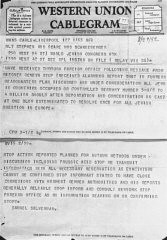
-
Henny Schermann
ID CardHenny's parents met in Germany soon after her father emigrated from the Russian Empire. Henny was the first of the Jewish couple's three children. The family lived in Frankfurt am Main, an important center of commerce, banking, industry and the arts. 1933-39: After the Nazis came to power, they began to persecute Jews, Roma (Gypsies), men accused of homosexuality, people with disabilities, and political opponents. In 1938, as one way of identifying Jews, a Nazi ordinance decreed that "Sara" was to be…

-
The Nuremberg Race Laws
ArticleThe Nazi regime’s Nuremberg Race Laws of September 1935 made Jews legally different from their non-Jewish neighbors. The laws were the foundation for future antisemitic measures .

-
Japan attacks Pearl Harbor
FilmWhile Japanese diplomats in Washington, DC, negotiated with Secretary of State Cordell Hull, Japanese planes bombed the naval base at Pearl Harbor. American outrage at the surprise attack overcame isolationist sentiment and the United States declared war on Japan the following day.
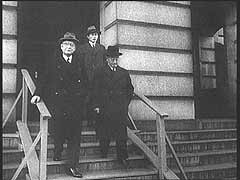
-
US Quakers aid children in defeated France
FilmDuring World War II , the American Friends Service Committee, a Quaker relief organization, provided food, shelter, and other aid to thousands of Jewish refugees—especially Jewish children—in France. The Quakers were active throughout France, even in areas occupied by German forces. In this footage, Quaker relief workers feed children at one of the Quaker-established schools in Marseille in the unoccupied southern zone of France.
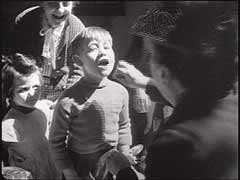
-
The Survivors
ArticleSurvivors faced huge obstacles in rebuilding their lives after the devastation of the Holocaust years. Learn about some of the challenges they faced.

-
Warsaw
ArticleIn October 1940, Nazi authorities established the Warsaw ghetto. Learn more about life in the ghetto, deportations, armed resistance, and liberation.

-
Hajj Amin al-Husayni: Wartime Propagandist
ArticleFormer Mufti of Jerusalem Hajj Amin al-Husayni was an exiled political leader who sought an alliance with the Axis Powers. Learn about his wartime propaganda efforts.
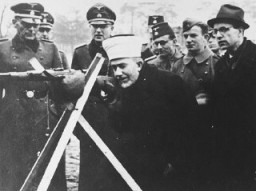
-
Holocaust Denial: Key Dates
ArticleBrowse a timeline listing some key events in the evolution of Holocaust denial and the distortion of the facts of the Holocaust.
-
Portrait of members of the Freemasons Lodge of Chernovtsy, Bukovina
PhotoGroup portrait of members of the Freemasons Lodge of Chernovtsy, Bukovina, approximately 75 percent of whom were Jewish. The members were mainly intellectuals and leaders in business and local government. Among those pictured are Dr. Max Ennis (top row, third from the left); pharmacist, Dr. Abraham Guttman (top row, far right); an official in the revenue service, Dr. Max Gottfried (second row from the top, sixth from the left); and the judge, Dr. Jacob Rubel (third row from the top, far left). Chernovtsy,…
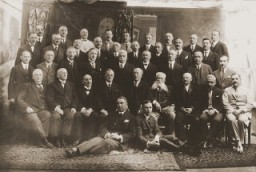
-
German Prewar Expansion
ArticleAdolf Hitler was determined to overturn the military and territorial provisions of the Treaty of Versailles. Learn more about Nazi German territorial aggression before WWII.
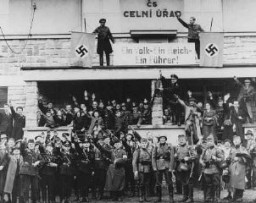
-
Austria
ArticleLearn about the German annexation of Austria, the establishment of Nazi camps, Kristallnacht, and deportations from Austria during the Holocaust.

-
Forced Labor: An Overview
ArticleForced labor played a crucial role in the wartime German economy. Many forced laborers died as the result of brutal treatment, disease, and starvation.
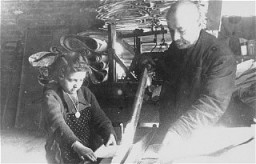
-
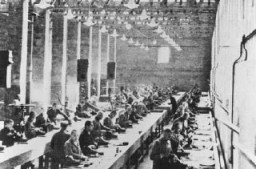
-
Hainichen
ArticleIn 1933, the Nazis established the Hainichen labor camp in Sachsen, Germany. Learn more about the camp, its closing, and the prisoners.
-
Jeno Muhlrad
ID CardJeno was the youngest of five children born to Jewish parents living in a suburb of Budapest. His father was a wholesale merchant who sold beer to restaurants and stores. After receiving a university diploma, Jeno became a pharmacist. He and his wife, Aranka, and their two children, Eva and Andras, shared a large old house in Ujpest with Jeno's father and other members of the extended family. 1933-39: Jeno's friends and family have helped him raise the large amount of money he needs to lease his own…

-
Dora Unger
ID CardDora, her parents, brother, aunt, uncle, and two cousins lived together in her grandfather's home in Essen, Germany. The Ungers were an observant Jewish family, and when Dora was 8, she began to regularly attend meetings of Brit HaNoar, a religious youth organization. 1933-39: In October 1938 a teacher, with tears in her eyes, came to Dora at the municipal pool, saying "Jews cannot swim here anymore." Just weeks later, on November 9, Jews were arrested and their property destroyed. A neighbor tried to…

-
Jeno Nemeth
ID CardJeno moved to Szentes from a tiny farming community near the city of Szolnok, where he and his two brothers had been born to Jewish parents. Jeno owned a store that carried groceries and hardware items. He lived in the southeast Hungarian town of Szentes. Jeno and his wife, Juliana, had two married daughters, Barbara and Margit. Their son, Desider, was a dentist in Szentes. 1933-39: Jeno and his wife work hard in their store. The Depression of the 1930s was devastating, but things are starting to get a…

-
Collaboration
ArticleTo perpetrate the Holocaust, Nazi Germany relied on the help of allies and collaborators from across Europe, including governments, institutions, and individuals.

-
Hidden Children: Hardships
ArticleParents, children, and rescuers faced daunting challenges once the decision was made for a child to go into hiding during the Holocaust.

-
Klaus Barbie: The Butcher of Lyon
ArticleKlaus Barbie, chief of the Gestapo in Lyon, France, was nicknamed the "Butcher of Lyon" for his brutal actions towards Jews and members of the French Resistance.
-
Voyage of the St. Louis
ArticleIn May 1939, the German transatlantic liner St. Louis sailed from Germany to Cuba. Most of the passengers were Jews fleeing Nazi Germany. Learn more about the voyage.

-
Röhm Affair
Timeline EventJune 30-July 2, 1934. On this date, Adolf Hitler ordered the Röhm Purge (also known as the "Night of the Long Knives").
-
Three metal boxes used to hold content of the Oneg Shabbat archive
ArtifactThree of the ten metal boxes in which portions of the Oneg Shabbat archive were hidden and buried in the Warsaw ghetto. The boxes are currently in the possession of the Jewish Historical Institute in Warsaw. In this view the three boxes are stacked on top of one another. The box on top is displayed on its side without the lid.
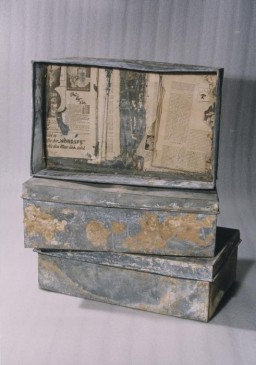
-
Refugee's suitcase
ArtifactA suitcase used (ca. 1939) by a Jewish refugee fleeing Nazi-occupied Europe to Japan. The suitcase is covered with labels from various stops along the journey, including one from a hotel in Moscow (top left), one for the NYK Line (top middle), and six from hotels throughout Japan. [From the USHMM special exhibition Flight and Rescue.]
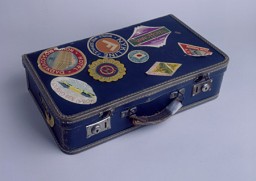
-
Beifeld album page about Soviet counteroffensive
Artifact(Top and bottom) The image at the top shows Hungarian soldiers abandoning their trenches on the front lines as a Soviet tank overruns the barbed wire fortification separating the two armies. The drawing at the bottom captioned "Alarm," shows Hungarian soldiers running back and forth sounding the alarm of the Soviet counteroffensive. The drawings are dated Jan 11 and 13, 1943. [Photograph #58103]

-
Life After the Holocaust: Aron and Lisa Derman
ArticleAfter WWII and the fall of the Nazi regime, Holocaust survivors faced the daunting task of rebuilding their lives. Listen to Aron and Lisa Derman's story.
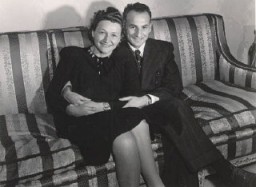
-
Lea Ofner-Szemere
ID CardLea was born in the city of Sombor in northeastern Yugoslavia. When she was 3 years old, her parents divorced and she moved to Vienna with her mother, who taught English and French to Austrian children. Lea enjoyed living in Vienna as a child. 1933-39: Lea returned to Sombor almost every year to visit her mother's relatives. There, she became reacquainted with her younger half-sister, Julia, and her older half-brother, Francis, and would miss them when she returned to Vienna. In 1938, the Germans annexed…

-
Szlamach Radoszynski
ID CardSzlamach was one of six children born to Yiddish-speaking, religious Jewish parents. Szlamach's father was a peddler, and the Radoszynski family lived in a modest apartment in Warsaw's Praga section on the east bank of the Vistula River. After completing his schooling at the age of 16, Szlamach apprenticed to become a furrier. 1933-39: During the 1930s Szlamach owned a fur business. Despite the Depression, he was hoping the economy would turn around so that he could make enough money to move into his own…

-
Isachar Herszenhorn (Irving Horn)
ID CardIsachar was born to a Jewish family in the Polish city of Radom, approximately 75 miles south of Warsaw. The city was the center of Poland's leather-tanning industry. Isachar's father worked as a salesman for a nearby tanning factory. His father was a successful salesman and the family lived comfortably. 1933-39: During registration for Isachar's first-grade class in 1934, a Jewish boy was pushed down the stairs. When his mother confronted the principal about the incident, all he said was that the boy had…

-
Laura Litwak
ID CardLaura was the second of five children born to religious Jewish parents in the industrial city of Lvov. She was often called affectionately by her nickname, Lorka. Coming from an educated family living in a multi-ethnic part of Poland, she grew up speaking Polish, Russian, German and Yiddish. As a young woman, she earned a humanities degree from St. Nicholas University in Lvov. 1933-39: In April 1935 Laura became Mrs. Daniel Schwarzwald. Her husband was a successful lumber exporter, and they lived in a…

-
War Refugee Board: Background and Establishment
ArticleIn January 1944, FDR established the War Refugee Board which was charged with “immediate rescue and relief of the Jews of Europe and other victims of enemy persecution.”

-
Alexander Schenker describes working as a lumberjack in a labor camp in Siberia
Oral HistoryFollowing the German invasion of Poland in September 1939, Alexander and his family fled eastward to Lvov. His father then fled to Vilna, hoping to obtain visas for the family to escape through Japan. The rest of the family was caught while trying to cross border into Lithuania in order to meet up with Alexander's father. They returned to Lvov. Alexander and his mother were later arrested for refusing to declare Soviet citizenship. They were sent to a labor camp in the Soviet interior. After their release…

-
Immediate American Responses to the Nazi Book Burnings
ArticleThe Nazi book burnings of 1933 sparked responses from anti-Fascist organizations, Jewish groups, and writers in the United States. Learn more.

-
SS and the Camp System
ArticleIn 1933-1934, the SS seized control of the Nazi camp system. Learn more about the persecution, forced labor, and murder that occurred under SS camp rule.

-
Introduction to the Definition of Genocide
ArticleExplore an outline of the main definitional elements of the crime of genocide and how significant aspects of the law have developed through recent cases.

-
Antisemitism
ArticleThroughout history Jews have faced prejudice and discrimination, known as antisemitism. Learn more about the long history of antisemitism.
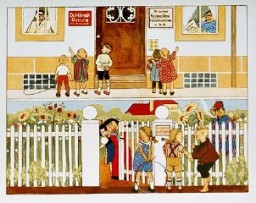
-
Oskar Schindler
ArticleOskar Schindler's actions to protect Jews during the Holocaust saved over 1,000 Jews from deportation. Learn more about Schindler's List.

